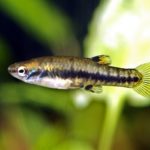Are you looking for information on caring for your Tire-Track Eels? Or maybe you want to know how to feed them properly? Well, you’ve come to the right place!
This article covers all aspects of caring for them and helping them thrive. It also includes some great tips on tank mates and other topics that will help keep your tire-track eels happy and healthy.
But before anything else, how do you recognize Tire-Track eels (Mastacembelus armatus)? Their bodies are in the classic eel shape, flattened laterally and with a snout-like face. They also closely resemble a snake due to their dark zigzag markings from head to tail.
Read on to find out more about this fascinating fish in detail.
Species Summary

Distributed over a wide area of Asia, the Tire Track Eel is a species of tropical freshwater eel belonging to the Mastacembelidae family.
The species occur in very different habitats between them. They are found in streams and rivers with sand, pebble, or boulder substrate in highland streams to lowland wetlands. They also dwell in areas of flooded forest.
If you’re thinking of keeping one in your home aquarium, it’s essential to keep in mind that this fish is large in size, making it difficult to maintain in small talk. This is also why it’s not very popular among common aquarists.
But the cool thing is, it’s a sought-after specie among the keepers of large fish. Its peaceful behavior toward other fish species in the community aquarium is one characteristic that causes an impact on those who observe it. That’s right, Tyre-Track Eels have been known to be quite tolerant of other tank mates.
Generally speaking, the Tire-Track Eel is a challenging and peaceful fish in aquariums, making it an excellent choice for experienced aquarists looking for something different in their tank. These fish prefer aquariums with low lighting and many hiding places; however, they always swim around the aquarium when well adapted and adequately managed.
Tire Track Eel Care Guide
Tire track eels are not difficult to care for, but they need some specific attention.
Tyre-track eels are one of the most commonly kept fish in community aquariums. Being adaptable species, they can be housed with other fish species and are capable of living peacefully with them.
In terms of care, they are not difficult to care for, but they need some specific attention. As long as you provide them with a balanced diet, plenty of hiding places, and plenty of swimming space, they will remain healthy and thriving.
However, Tire-Track Eels can be sensitive to sudden changes in their environment. For example, if they are removed from their home and placed into a new tank, the odds are that they could become stressed. If you don’t want that to happen, ensure that the food and tank requirements are stable.
Tank Size
Tire-track Eel is a relatively active fish, spending most of their time lurking in their caves and then hunting and exploring the territory at night. Because of their large size, they demand a large-volume aquarium.
A 48″ x 24″ aquarium or somewhere around 132 gallons is a good size to start with. However, the best thing you can do for your Tire-Track Eel is to provide it with plenty of open water and tight channels – suitable conditions for hunting and scavenging. This will give you the best chance at having a healthy, happy fish.
Tank Mates
They are semi-aggressive eels that coexist without problems with other fish species in a community aquarium. However, keeping the Tire Track Eel with larger fish that cannot be eaten would be best. Likewise, avoid keeping it with other territorial and aggressive fish.
Tire Track Eels should be kept with medium to large semi-aggressive species, such as:
Ideally, Tire Track eels should be kept with similar species that will not harm the eel but also be seen as food to the Tire Track eel.
Same Species Tanks
The Tire Track Eel is rarely used as a single species in any type of assembly; it’s safe to keep the animal in a group.
Water Parameters
They are relatively hardy fish but cannot withstand sudden changes in parameters. This species is also sensitive to water pollutants and organic matter accumulation in the aquarium. In addition, this fish can live with outstanding quality in different parameters. The perfect temperature for its maintenance is from 75 to 82 F. The ideal pH range is between 6.0 and 7.0, and the hardness ranges from 5 to 12°H.
Note that this fish does well in slightly brackish water (high hardness). This difference between hardness and pH is related to the region of origin of the specimen and demonstrates the oscillation of parameters during the dry and rainy seasons.
What to Put in Their Tank
Like any other captive-bred fish, Tire Track Eels need an aquarium heater and a filtering system in their tank to be healthy. The filtration system must be well-dimensioned, and since these fish are fantastic jumpers, the tank must be covered fitted and appropriately secured.
The aquarium’s decoration will also be crucial in maintaining the species, which needs many hiding places and caves. A densely planted aquarium is your best bet for a suitable home for your Tire Track Eel.
We recommend you use lots of rocks and driftwood in forming caves and hiding places. Sand as a substrate is also welcome, as these creatures like to bury themselves.
Common Diseases
These eels are remarkably disease-resistant fish. But, they are prone to fungus and parasites because of the small scales protecting their body. They’re also sensitive to medications, so avoid copper-based drugs as Tyre-Track eels respond poorly to it.
Ultimately, keep the tank and water quality in optimal conditions at all times, so your fish will not present any health-related problems. Remember to always quarantine new fish before placing them in the main tank.
Food and Diet
Tire Track eels are omnivorous and nocturnal, feeding on benthic invertebrates, fish, detritus, and plant material. In their natural habitat, the primary diet is based mainly on live fish, benthic insect larvae, worms, and other aquatic invertebrates. They feed on vegetal material as well.
But in aquariums, they have problems accepting commercial rations. Instead, they prefer fresh, live food such as live fish, brine shrimp, bloodworms, and earthworms.
Feeding a Tyre Track eel can be a bit tricky. You don’t want to overfeed them, as this can cause improper digestion and health problems, but you also don’t want to underfeed them, as this could lead to starvation and death. A good rule of thumb is to feed them a few times a week.
Providing a varied and balanced diet is essential for demonstrating its full potential. But, in general, these fish always seem to be hungry.
Lifespan
In an aquarium with all the correct parameters kept stable and with an ideal diet, this fish can live for up to 18 years, the most common being around 10 years. So just imagine how long you can enjoy the benefits of having this stress-reliever companion!
In nature, these animals are prone to live less, as they are predisposed to diseases, attacks from other animals, and environmental causes.
Appearance
An adult Tire-track Eel feature an elongated body and a long snout, the dorsal and anal fins are extended and joined to the caudal fin. It has a light-colored, slightly brownish base body and a darker zig zag-shaped marking along the body, crossing the animal’s eye laterally. This tag conferred one of its names, “Zig-Zag Eel.”
Size
The Tire Track Eel can easily reach 35 inches in length when well-cared for and fed. However, the most common in domestic aquariums is to find animals around 20 inches in length.
Behavior and Temperament
These fish are surprisingly peaceful and likes to stay out of the way. While this is the case, they can mistake smaller fish for food, thus why it’s best to keep them in a community aquarium with larger fish or of the same size.
As mentioned, Tyre-Track eels can live in harmony with other fish species in the tank as long as they have a similar temperament.
They’re not very active swimmers during the day, but you can find them around open swimming spaces during the night.
Breeding
There are very few reports of its reproduction in domestic aquariums. One of the reasons for this is the difficulty of keeping more than one fish in the same aquarium and the problem of sexing them correctly. Nevertheless, even though only empirically contacted, probably essential conditioning for tropical fish works with Tyre-track eels.
It is an oviparous species, and no parental care occurs. The courtship process takes several hours, where they chase each other and swim in circles.
The female then lays the eggs between the roots of floating plants. The eggs are adherents which attach to the plants and hatch in 3 to 4 days. The fingerlings become free-swimming in a few more days and accept being fed nauplii well.
However, larviculture is a challenging and complicated process, as fingerlings are susceptible to fungal infections.
Gender Differences: Male vs. Female
There is no apparent sexual dimorphism. Yet, experienced hobbyists say that adult males are wider and more robust when viewed from above.
Tire-Track Eel Fun Facts
- This fish is not scientifically considered to be a true eel despite looking like one. But like all members of the Mastacembelidae family, they are known as spiny eels; this classification of eel is only related to the shape of its body.
- This tropical freshwater eel species was recognized and described by Lacepède in the 1800s. Since the modern aquarium hobby began, it has been a famous and desired species.
- The Tire Track eel has many common names, such as Tyre Track Eel, Spiny Eel, White-Spotted Spiny Eel, Marbled Spiny Eel, Giant Spiny Eel, Giant Mottled Eel, Car Track Spiny Eel, and Leopard Spiny Eel.
- The correct identification of the animal through its common name alone may be incorrect, as different species of spiny eels are called Tire-Track Eel. It is commonly used to designate at least three species, M. armatus, M. favus, and Macrognathus circumcinctus. In addition, M. armatus and M. favus are also frequently identified because they contain similar characteristics during their juvenile phase. Overall, their coloring is quite similar, but the placement of the reticulated marking pattern on the body is the most distinctive element.
- The Tire-Track Eel (Mastacembelus armatus) is one of the most common fish species available for the hobby and can be found in stores worldwide.
- This family of fish is commonly called ‘thorny eels’ due to the presence of spines along the fish’s back. It is worth mentioning that these are harmless to humans.
By now, you’ll have realized that Tire-Track eels can make a fun addition to your home aquarium. In terms of care, they require plenty of space and just the right amount of food, but if you can provide for all these requirements, then you will be able to enjoy this peaceful creature for years to come.
References
Dr. Herbert R. Axelrod, Aquarium Fishes of the World, TFH Publications, 1998 Dr. Herbert R. Axelrod.
Dr. Rüdiger Riehl and Hans A. Baensch, Aquarium Atlas Vol. 1, Publisher Hans A. Baensch, 1991.
Dr. Warren E Burgess, Dr. Cliff W. Emmens, Neal Pronek, Jerry G. Walls, Ray Hunziker,Dr. Axelrod’s Mini-Atlas of Aquarium Fishes, Mini- Edition, T.F.H. Publications, Inc., 1987.
Joseph S. Nelson, Fishes of the World, Wiley, 2006.
Mastacembelus armatus (Lacepède, 1800) Zig-zag eel, Fishbase.org.
Neale Monks, Brackish Water Fishes: An Aquarist’s Guide to Identification, Care & Husbandry, TFH Publications, 2006.








